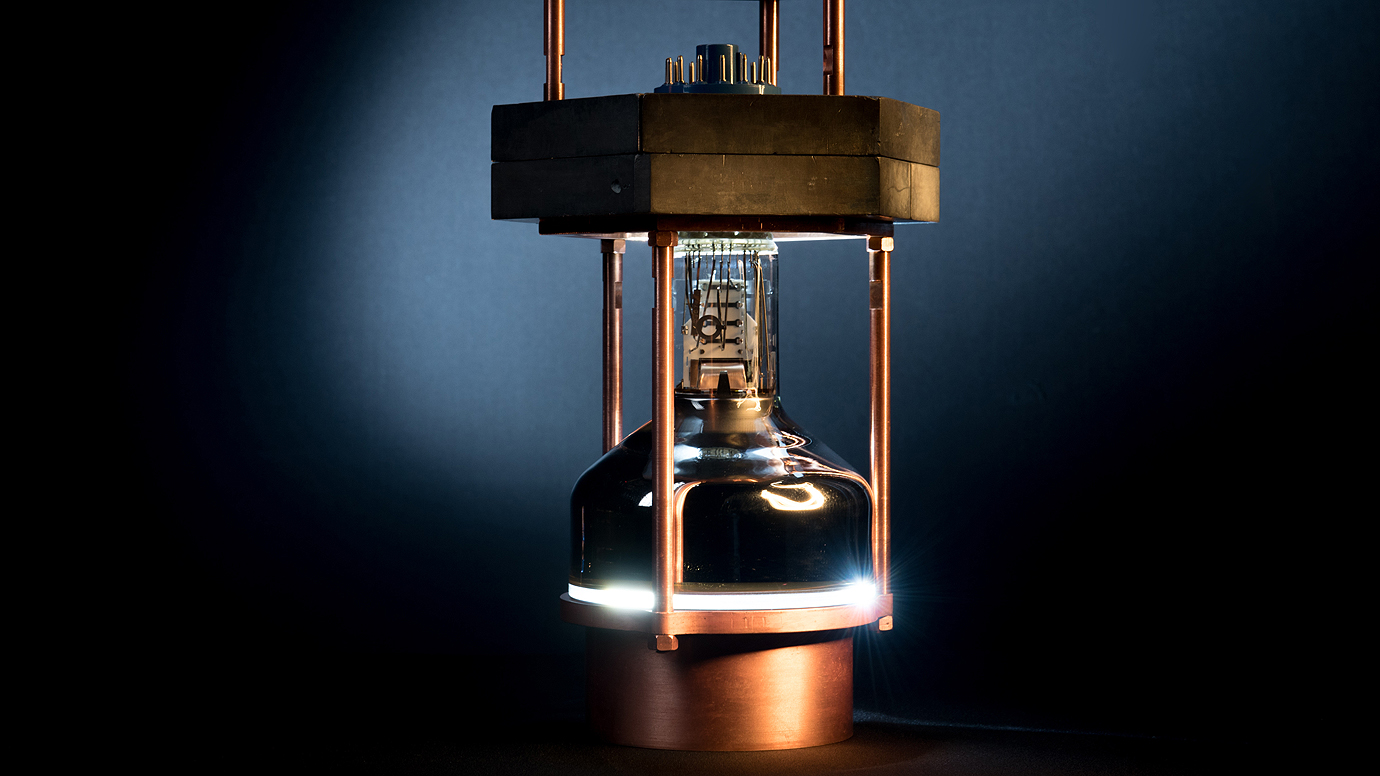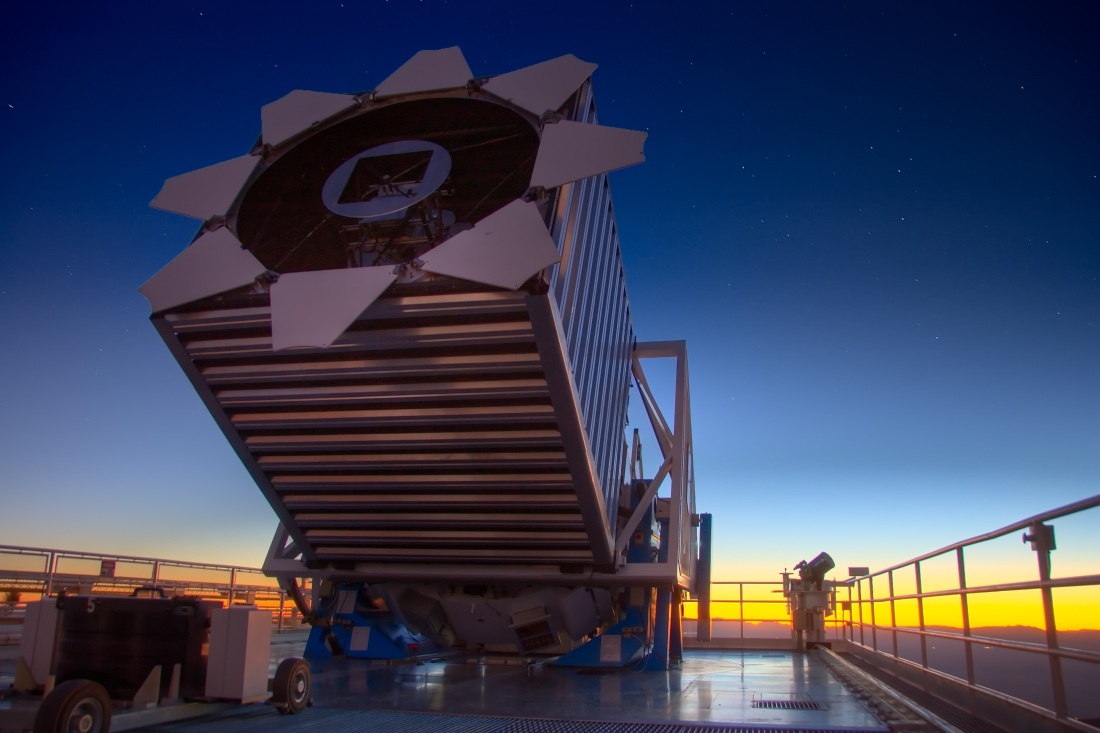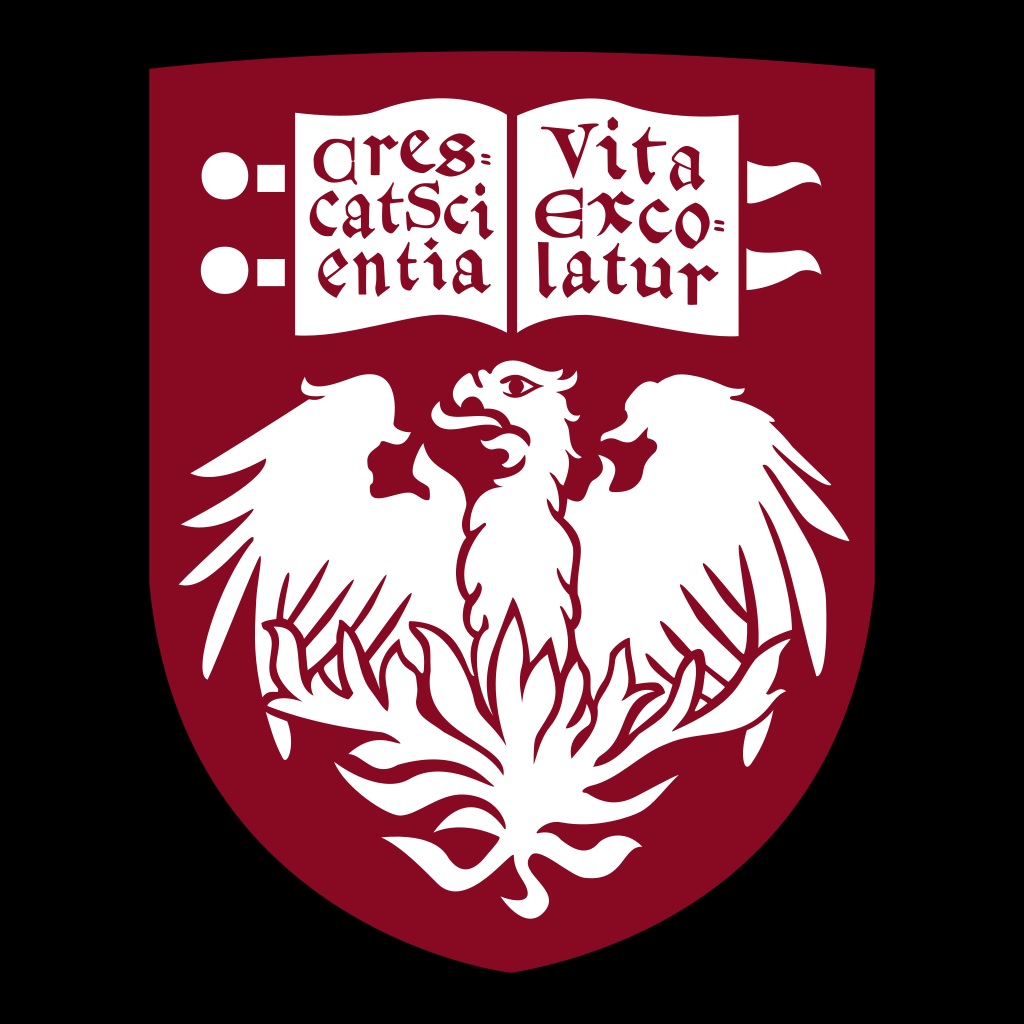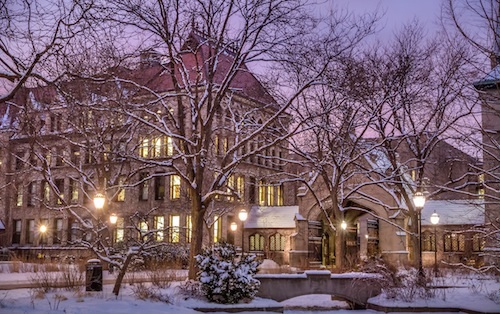From The University of Chicago (US)
Feb 24, 2022
Louise Lerner

University of Chicago graduate student Mark Lewis observes the compact neutrino detector (visible as the black cube on top of a silver platform) next to the containment wall of a reactor at Constellation’s Dresden Generating Station. Photo courtesy Collar lab.
‘Ghost particles’ research could bolster physics, nuclear nonproliferation.
A nuclear reactor at an Illinois energy plant is helping University of Chicago scientists learn how to catch and understand the tiny, elusive particles known as neutrinos.
At Constellation’s (formerly Exelon) Dresden Generating Station in Morris, Illinois, the team took the first measurements of neutrinos coming off a nuclear reactor with a tiny detector. These particles are extremely hard to catch because they interact so rarely with matter, but power reactors are one of the few places on Earth with a high concentration of them.
“This was an exciting opportunity to benefit from the enormous neutrino production from a reactor, but also a challenge in the noisy industrial environment right next to a reactor,” said Prof. Juan Collar, a particle physicist who led the research. “This is the closest that neutrino physicists have been able to get to a commercial reactor core. We gained unique experience in operating a detector under these conditions, thanks to Constellation’s generosity in accommodating our experiment.”
With this knowledge, the group is planning to take more measurements that may be able to tease out answers to questions about the fundamental laws governing particle and nuclear interactions.
The technique may also be useful in nuclear nonproliferation, because the neutrinos can tell scientists about what’s going on in the core of the reactor. Detectors could be placed next to reactors as a safeguard to monitor whether the reactor is being used for energy production or to make weapons.
“Orders of magnitude”
Neutrinos are sometimes called “ghost particles” because they pass invisibly through almost all matter.

(Billions have already zipped through your body today without your notice, en route from elsewhere in outer space.) But if you can catch them, they can tell you about what’s happening where they came from, and about the fundamental properties of the universe.
In particular, scientists would like to learn about specific aspects of neutrino behavior—whether they have electromagnetic properties (for instance, a “magnetic moment”), and whether they interact with as yet unknown particles hiding from our notice, or in new ways with known particles. Taking extensive measurements of as many neutrinos as possible can help narrow down these possibilities.
The need for many neutrinos is what drew Collar’s team to nuclear reactors. “Commercial reactors are the largest source of neutrinos on Earth by orders of magnitude,” he said. In the normal course of operation, nuclear reactors produce astronomical numbers of neutrinos per second. They occur when atoms inside the reactor break up into lighter elements, and release some of the energy in the form of neutrinos.
However, there’s a problem. Because neutrinos are so lightweight, and interact so rarely, scientists normally have to find them by filling an enormous tank with detecting fluids and then search for the telltale signal that a passing particle has produced one of a number of known reactions in it.
But there’s no room inside a commercial nuclear reactor for a multi-ton detector. The researchers needed something much, much smaller. Luckily, Collar is an expert in building such devices; he previously lead a team that built the world’s smallest neutrino detector.

The international COHERENT Collaboration, which includes physicists at UChicago use a detector that’s small and lightweight enough for a researcher to carry. Their findings, which confirm the theory of The DOE’s Fermi National Accelerator Laboratory (US)’s Daniel Freedman, were reported Aug. 3 in the journal Science.
In a second stroke of luck, Illinois is one of the leading nuclear energy states—about half the state’s electricity is generated at nuclear reactors. Constellation granted Collar permission to test the detector at Dresden Generating Station, one of the first-ever commercial nuclear plants in the nation.

An exterior view of Commonwealth Edison Company’s Dresden nuclear power station near Morris, Illinois.
Credit: The Department of Energy (US).
Previously, Collar and his team had tested their tiny detectors at a particle accelerator in The DOE’s Oak Ridge National Laboratory in Tennessee, where they were able to carefully control much of the environment in order to get a good signal. But in order for the detector to work at Dresden, they had to build a new version adapted to deal with the much noisier environment of an operating commercial reactor.
“You’re getting radiation, heat, vibration from the turbines, radiofrequency noise from the pumps and other machinery,” Collar said. “But we managed to work around all the challenges that were thrown our way.”
They designed the detector with a complex multi-layered shielding to protect it from other stray particles that would contaminate the data. Eventually, they were able to leave the detector in place to function unattended for several months, taking data all the while.
The team next hopes to take data at another reactor down the road at Constellation’s Braidwood Generating Station, or at the Vandellòs nuclear plant in coastal Spain. “This method can really contribute to our understanding of neutrino properties,” Collar said. “A lot of theoretical knowledge can be extracted from our data.”
The knowledge about operating small detectors in such noisy environments is also in high demand. “There is an interest in the nuclear nonproliferation community to set detectors next to reactors, because they can tell you what’s going on in the core—revealing any deviations from the declared use,” Collar said.
The output of neutrinos changes according to what kind of fuel the reactor is burning and what it’s producing, so detectors should be able to monitor for warning signs of weapons production, or whether fuel is being secretly diverted elsewhere. But to make this goal a reality, such detectors would have to be small, robust and easy to use; Collar said the Dresden work helps gather valuable data to make such detectors possible.
There may also be many other uses for neutrino detectors. “For example, once we have sufficiently sensitive neutrino detectors, you could use them to map the interior of the Earth—perhaps even detect oil or other useful deposits,” Collar said. “A lot of thinking along these lines has been done, but it is still in the future.”
While working on the design, Collar was reminded that his laboratory on campus continues a line of work initiated by Prof. Willard Libby in the 1950s to discover how to use carbon-dating to tell the age of an object.
“These pioneers had to come up with techniques that we still use today to find a relatively small signal amongst a great deal of background noise,” he said. “It’s rewarding to think our work is part of a long local tradition. And Illinois is a special place for nuclear power generation, for similar reasons.”
Science papers:
Suggestive evidence for Coherent Elastic Neutrino-Nucleus Scattering from reactor antineutrinos
See the full article here .
five-ways-keep-your-child-safe-school-shootings
Please help promote STEM in your local schools.
The University of Chicago (US) is an urban research university that has driven new ways of thinking since 1890. Our commitment to free and open inquiry draws inspired scholars to our global campuses, where ideas are born that challenge and change the world.
We empower individuals to challenge conventional thinking in pursuit of original ideas. Students in the College develop critical, analytic, and writing skills in our rigorous, interdisciplinary core curriculum. Through graduate programs, students test their ideas with University of Chicago scholars, and become the next generation of leaders in academia, industry, nonprofits, and government.
University of Chicago research has led to such breakthroughs as discovering the link between cancer and genetics, establishing revolutionary theories of economics, and developing tools to produce reliably excellent urban schooling. We generate new insights for the benefit of present and future generations with our national and affiliated laboratories: DOE’s Argonne National Laboratory (US), DOE’s Fermi National Accelerator Laboratory (US), and the Marine Biological Laboratory in Woods Hole, Massachusetts.
The University of Chicago is enriched by the city we call home. In partnership with our neighbors, we invest in Chicago’s mid-South Side across such areas as health, education, economic growth, and the arts. Together with our medical center, we are the largest private employer on the South Side.
In all we do, we are driven to dig deeper, push further, and ask bigger questions—and to leverage our knowledge to enrich all human life. Our diverse and creative students and alumni drive innovation, lead international conversations, and make masterpieces. Alumni and faculty, lecturers and postdocs go on to become Nobel laureates, CEOs, university presidents, attorneys general, literary giants, and astronauts. The University of Chicago is a private research university in Chicago, Illinois. Founded in 1890, its main campus is located in Chicago’s Hyde Park neighborhood. It enrolled 16,445 students in Fall 2019, including 6,286 undergraduates and 10,159 graduate students. The University of Chicago is ranked among the top universities in the world by major education publications, and it is among the most selective in the United States.
The university is composed of one undergraduate college and five graduate research divisions, which contain all of the university’s graduate programs and interdisciplinary committees. Chicago has eight professional schools: the Law School, the Booth School of Business, the Pritzker School of Medicine, the School of Social Service Administration, the Harris School of Public Policy, the Divinity School, the Graham School of Continuing Liberal and Professional Studies, and the Pritzker School of Molecular Engineering. The university has additional campuses and centers in London, Paris, Beijing, Delhi, and Hong Kong, as well as in downtown Chicago.
University of Chicago scholars have played a major role in the development of many academic disciplines, including economics, law, literary criticism, mathematics, religion, sociology, and the behavioralism school of political science, establishing the Chicago schools in various fields. Chicago’s Metallurgical Laboratory produced the world’s first man-made, self-sustaining nuclear reaction in Chicago Pile-1 beneath the viewing stands of the university’s Stagg Field. Advances in chemistry led to the “radiocarbon revolution” in the carbon-14 dating of ancient life and objects. The university research efforts include administration of DOE’s Fermi National Accelerator Laboratory(US) and DOE’s Argonne National Laboratory(US), as well as the U Chicago Marine Biological Laboratory in Woods Hole, Massachusetts (MBL)(US). The university is also home to the University of Chicago Press, the largest university press in the United States. The Barack Obama Presidential Center is expected to be housed at the university and will include both the Obama presidential library and offices of the Obama Foundation.
The University of Chicago’s students, faculty, and staff have included 100 Nobel laureates as of 2020, giving it the fourth-most affiliated Nobel laureates of any university in the world. The university’s faculty members and alumni also include 10 Fields Medalists, 4 Turing Award winners, 52 MacArthur Fellows, 26 Marshall Scholars, 27 Pulitzer Prize winners, 20 National Humanities Medalists, 29 living billionaire graduates, and have won eight Olympic medals.
The University of Chicago is enriched by the city we call home. In partnership with our neighbors, we invest in Chicago’s mid-South Side across such areas as health, education, economic growth, and the arts. Together with our medical center, we are the largest private employer on the South Side.
In all we do, we are driven to dig deeper, push further, and ask bigger questions—and to leverage our knowledge to enrich all human life. Our diverse and creative students and alumni drive innovation, lead international conversations, and make masterpieces. Alumni and faculty, lecturers and postdocs go on to become Nobel laureates, CEOs, university presidents, attorneys general, literary giants, and astronauts.
Research
According to the National Science Foundation (US), University of Chicago spent $423.9 million on research and development in 2018, ranking it 60th in the nation. It is classified among “R1: Doctoral Universities – Very high research activity” and is a founding member of the Association of American Universities (US) and was a member of the Committee on Institutional Cooperation from 1946 through June 29, 2016, when the group’s name was changed to the Big Ten Academic Alliance. The University of Chicago is not a member of the rebranded consortium, but will continue to be a collaborator.
The university operates more than 140 research centers and institutes on campus. Among these are the Oriental Institute—a museum and research center for Near Eastern studies owned and operated by the university—and a number of National Resource Centers, including the Center for Middle Eastern Studies. Chicago also operates or is affiliated with several research institutions apart from the university proper. The university manages DOE’s Argonne National Laboratory(US), part of the United States Department of Energy’s national laboratory system, and co-manages DOE’s Fermi National Accelerator Laboratory (US), a nearby particle physics laboratory, as well as a stake in the Apache Point Observatory (US) in Sunspot, New Mexico.
_____________________________________________________________________________________
 SDSS Telescope at Apache Point Observatory, near Sunspot NM, USA, Altitude 2,788 meters (9,147 ft).
SDSS Telescope at Apache Point Observatory, near Sunspot NM, USA, Altitude 2,788 meters (9,147 ft).
 Apache Point Observatory (US), near Sunspot, New Mexico Altitude 2,788 meters (9,147 ft).
Apache Point Observatory (US), near Sunspot, New Mexico Altitude 2,788 meters (9,147 ft).
_____________________________________________________________________________________
Faculty and students at the adjacent Toyota Technological Institute at Chicago collaborate with the university. In 2013, the university formed an affiliation with the formerly independent Marine Biological Laboratory in Woods Hole, Mass. Although formally unrelated, the National Opinion Research Center (US) is located on Chicago’s campus.


